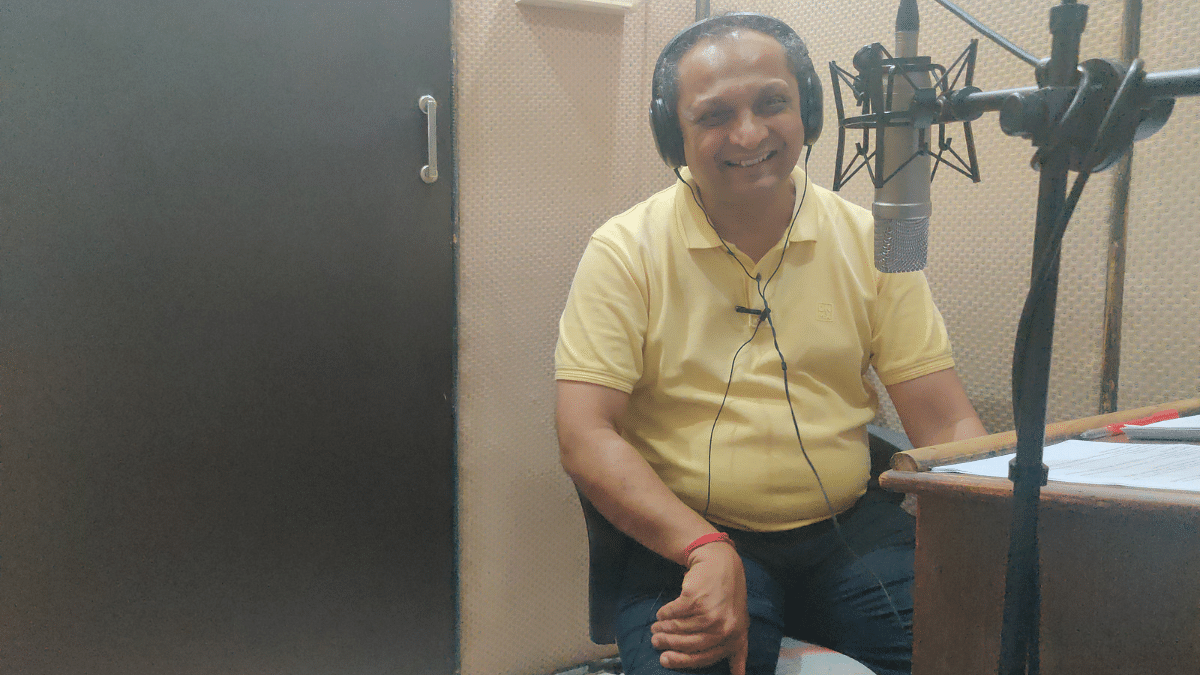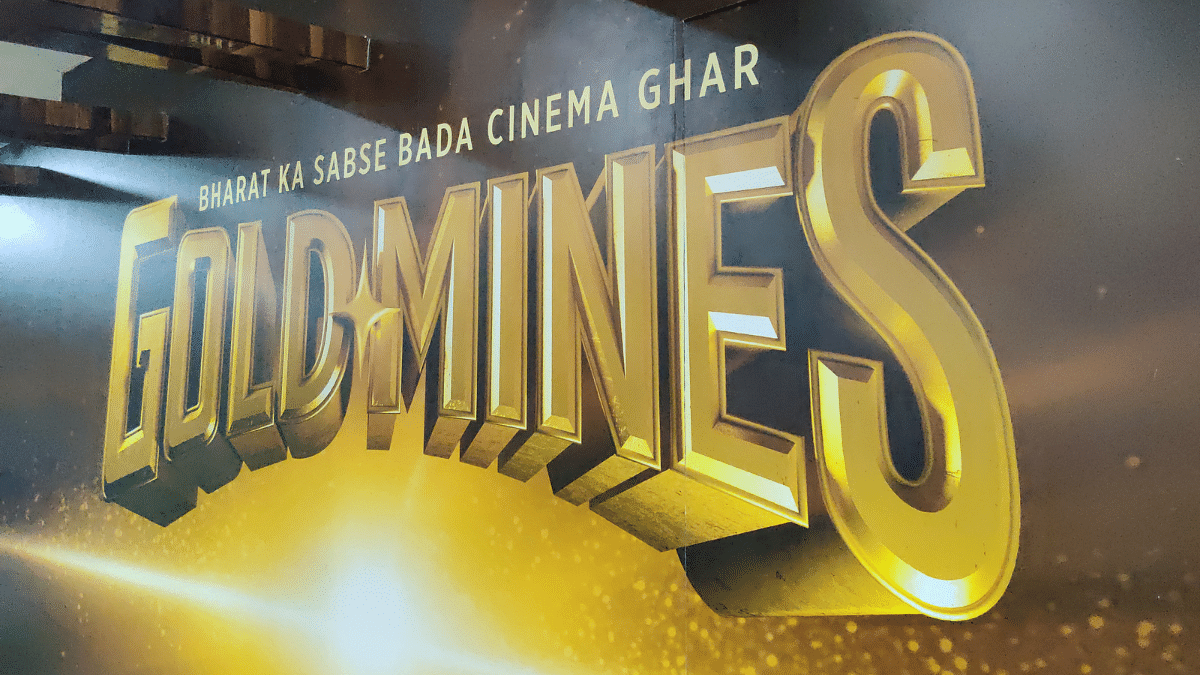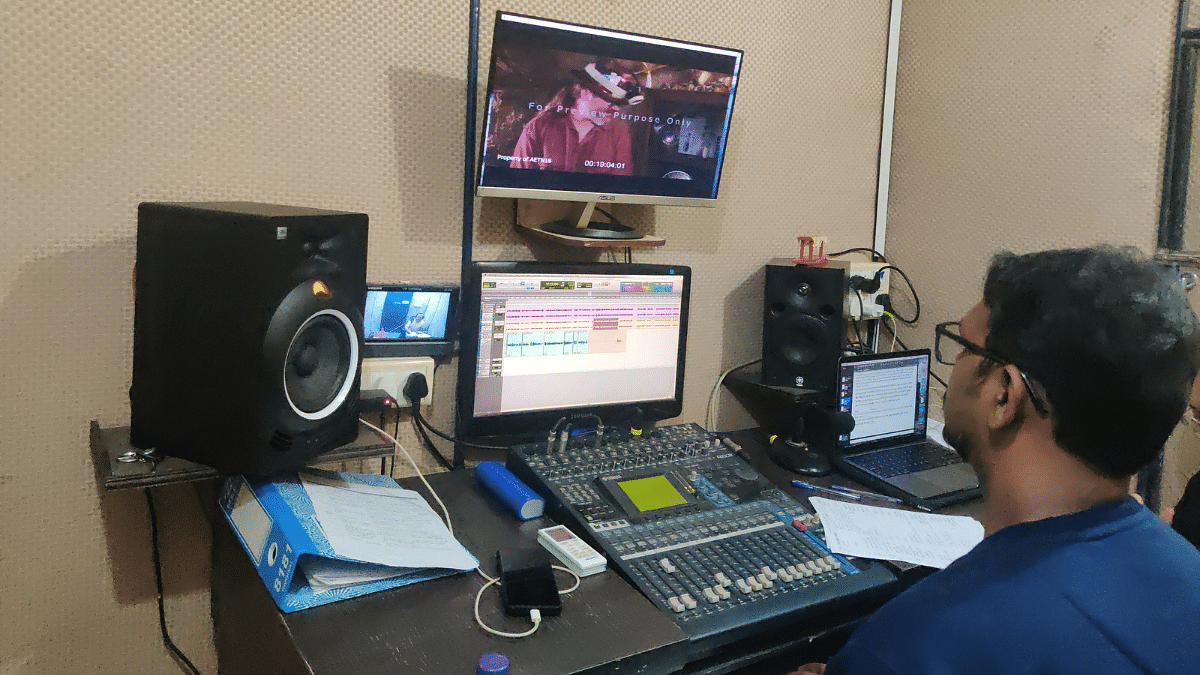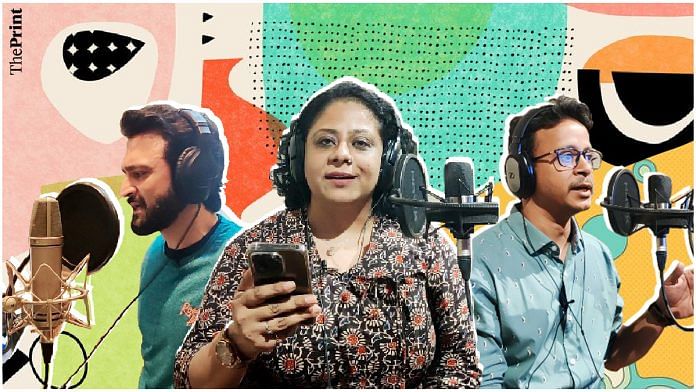Mumbai: Average Joe Mayur Vyas dissolves into the frantic crowds of Mumbai’s local trains every morning as he sets out from Malad to teach at a B-school in Vile Parle. By day, he is consumed with marketing and advertising subjects. But by night, he sheds his cloak and magically morphs into “Thailaiva” Rajinikanth, belting out dialogues like ‘jhund mein toh suar aate hai munna, sher akele hi aata hai’ or ‘main dikhta ek insaan hu par hu machine’.
In the Hindi-speaking regions of North India, Vyas, for all practical purposes, is the superstar Rajinikanth. It is his voice that reverberates through packed theatres and television channels, bringing Rajinikanth’s dubbed Hindi films to life. From 2010 to 2022, Vyas has lent his voice to the southern megastar in ten films — Sivaji: The Boss, Enthiran, Lingaa, Kabali, Pedarayudu, Kaala, 2.0, Darbar, Annaatthe, and Chandramukhi. Just last week, he returned from Chennai after completing the dubbing for Rajinikanth’s upcoming film Jailer, set to release on 11 August.
Vyas has embraced his alter ego to such an extent that it becomes challenging for him to shed Rajinikanth’s trademark laugh, dramatic style, and flair when he switches to a professorial tone in the classroom. Even his students have special dialogue requests during breaks.
“The job can easily be done with a southern accent, but that will be mimicry. You need to sound original to match up to the actor’s style and attitude. That’s the challenge,” Vyas recalls with a smile, sitting in a dubbing studio in Goregaon West.

Vyas is part of Bollywood’s invisible but not-so-silent army of voice artists, who have single-handedly created the massive, Ka-ching phenomenon of pan-Indian south-north crossover cinema. These voice artists remain faceless, known only by their dismembered voices. They don’t receive stardom, Instagram followers, or the pap-love, yet they are the reason the Indian film industry has survived these gloomy years.
These voice artists spend their lives in darkness, speaking others’ dialogues into a microphone, often elevating scenes and outperforming the original film. The breakthrough success of Baahubali in the Northern belt is widely attributed to the Hindi voice dubbing of its protagonist Prabhas, done by Sharad Kelkar. Voice artists have been instrumental in bridging the gap between different language-speaking audiences. Before the Hindi dubbed versions of Baahubali, K.G.F. 2.0, RRR, Pushpa: The Rise, and Kantara raked in crores of rupees, it was the reruns of dubbed versions on TV that made the who’s who of South Indian film industry satellite stars in North India.
“Dark, no windows, no light and you walk inside. The moment I close that door, I leave everything behind and become someone else. From thereon, the audience knows me and the actor, whether it’s Ryan Reynolds or Ram Charan, as one person,” says Sanket Mhatre, a voice artist with a 17-year career, who has dubbed for famous cartoon characters like Ben 10 and top South superstars such as Allu Arjun, Mahesh Babu, NT Rama Rao Jr, Naga Chaitanya, and Vijay Deverakonda.

Also read: Marble, glass, steel: Indian architects caught between desires of cash-rich & climate alarm
Studio owners, teachers, social media stars
Dubbing studios are scattered across the Western Suburbs of Mumbai, from Malad to Andheri. But there is no clear career path, fame, or money for voice artists. Beginners are paid a pittance sum of Rs 40,000 to Rs 45,000 per project, and the pay is even lower for crowd dubbing. Like any artist, voice actors must adapt to the changing times. Many experienced artists are taking up new challenges to stay relevant.
While some voice artists are establishing themselves as educators, others aim to teach aspiring artists about the struggles and experiences they face.
“I once met a fan who left his home in Jammu and Kashmir and came to Mumbai to become a voice actor. When he couldn’t make it, he took up a job on a cruise to make ends meet,” recalls Mhatre, explaining why he started creating educational videos for aspiring voice actors.
Mhatre’s videos on YouTube and Instagram cover techniques like breathing during dubbing, maintaining the ‘perfect distance’ between a pop filter and the mouth, dealing with stammering, and setting up a home studio. He shares his expertise based on his own journey, which began when he stumbled upon a microphone after realising that engineering wasn’t his true calling.
The road to success wasn’t easy for Mhatre. His first dubbing ended in disaster, but he gradually improved his skills through crowd dubbing and small gigs. Most voice artists learn on the job, listening to other artists and following the instructions of the dubbing director.
Now, after 17 years in the industry, Mhatre is one of the most sought-after voice artists, working in web series, animation, audio descriptions, and feature films, both in Hindi and English. He often travels to studios for recordings but also has a makeshift studio at his home in Andheri East. However, being a prominent name doesn’t exempt him from auditions for potential projects and characters.
Rajesh Kava, another voice artist, has also taken it upon himself to educate the younger generation. He has held one-on-one sessions and conducted monthly 10-day courses at his office in Kandivali. Kava, who migrated from Gujarat to Mumbai, learned the ropes of the industry through hands-on experience since there were no classes or guidance available when he started.
“I learned everything on the job. Rejection can be ruthless, and initially, I was often turned away without any feedback. Nobody had time for that,” says Kava. He has lent his voice to characters like ‘Jaggu bandar’ in the cartoon series Chhota Bheem, and Harry Potter in the last three Hindi-dubbed films of the franchise, along with several comedic characters in dubbed South Indian films.
“When you adapt to the local language, you have widened the audience space. Hence, a strong grasp of the language is the most important and fundamental requirement,” he adds.
While artists like Mhatre and Kava step into the role of educators, veteran voice artists like Mona Ghosh Shetty and Toshi Sinha have taken charge of their careers and run their own businesses.

Mona’s studio, ‘Sound & Vision India’, is located in Andheri West, overlooking Juhu Versova Link Road. She is the daughter of renowned voice artist Leela Ghosh, a pioneer in popularising dubbing in India and a founding member of the Association of Voice Artists. Mona has continued her mother’s legacy.
Many films featuring actresses like Katrina Kaif, Nargis Fakhri, Deepika Padukone, Rani Mukerji, Bipasha Basu, Jacqueline Fernandez, and Kareena Kapoor bear Mona’s voice. What Mona does is ‘voice acting’. She takes offence at being recognised as a ‘dubbing artist’. These days, her focus has shifted more towards managing the studio.
“As I have aged so have the actresses who I have voiced over the years. The voice has also matured with time,” says Mona, whose last project was voicing Jennifer Lopez in Hindi for the Hollywood film The Mother. In addition to over fifty Hollywood film credits, she has also dubbed for Nayanthara in the Telugu film Sye Raa Narasimha Reddy (2019).
Just three kilometres away from Mona’s studio lies Kutumb Studio on Veera Desai Road in Andheri, run by voice artist Toshi Sinha and her younger brother. The studio has completed two years this year.
Toshi, who grew up in the ’90s watching Disney shows, has been an integral part of many childhoods. She has provided the voice for leading actors in over 150 episodes of shows like That’s So Raven and Lizzie McGuirein in Hindi. Apart from dubbing for several leading ladies of the South — Trisha Krishnan, Anushka Shetty, Jyothika, Nithya Menen — she has worked as the promo voice for channels like Colors and provided audio voiceovers for Air India.
“If you have watched television, travelled the world, or listened to the radio, we probably have met each other already. Main har ghar ki awaaz hoon (I am a household voice),” she says, reflecting on her 22-year-old career.
Also read: South Korea building on K-pop craze to boost art scene. And India is part of its ‘big mission’
One man built an empire
But South Indian cinema wasn’t always the toast of town that it has now become. The aesthetics of Hindi and Tamil and Telugu audiences were considered to be vastly different and the Hindi dubbed versions of Hollywood films were having a heyday. Then it changed. One man saw a potential that no one else did.
In 2007, Manish Shah, a Mumbai-born television soap producer, reached out to Sony with the idea of airing a Telugu film dubbed into Hindi. Though skeptical, the network agreed. Mass, starring Nagarjuna, became Meri Jung: One Man Army in Hindi, which was telecast on Sony MAX. It garnered TRPs of over 1, which was significant at the time.
Since then, Shah’s production house, Goldmines Telefilms, located in Malad, has been acquiring the rights to old South Indian films (Tamil, Telugu, Kannada, and Malayalam), dubbing them into Hindi, and selling them to broadcast networks or uploading them on its YouTube channels. Notable films include Allu Arjun’s Sarrainodu, Dhanush’s Anegan, Keerthy Suresh’s Mahanati, and Vijay Deverakonda’s Dear Comrade.

“Especially in tier-2 and tier-3 cities, Hindi dubs of South Indian films are being consumed like hotcakes. Goldmines cracked that code. They packaged a South Indian film as per the taste of North Indians — no songs, altered the cultural nuances, and edited the length,” says Mhatre.
Goldmines has maintained a steady supply of dubbed southern language blockbusters to satellite channels for over a decade. With the success of Pushpa: The Rise, Goldmines even made a foray into theatres. It bought the rights of the dubbed Hindi version of Allu Arjun’s mega-blockbuster for Rs 30 crore and roped in Shreyas Talpade. The film shattered box office records. Later, the streaming rights were sold to Amazon Prime Video.
A walk into Shah’s office provides a glimpse into his love for South Indian cinema. The reception area features a dozen TV screens playing Telugu, Malayalam, Tamil, and Hindi films on mute. Goldmines now has its own channel where dubbed films are streamed non-stop. The office includes a corridor adorned with posters of famous South Indian films, labelled as ‘Manish Shah’s Sarrainodu’ or ‘Manish Shah’s Pushpa’. On the other end of the hall is a makeshift theatre room where the films are screened for Shah to evaluate and deliberate upon. He watches all South language films but prefers Telugu.
“Whether in Mumbai, Chennai, or on the flight, I ensure that I watch one film every day,” says Shah, who returned from the sultry hot Chennai to rainy Mumbai that morning.
With over 6,000 videos, his YouTube channel, Goldmines, boasts 87 million subscribers and more than 24 billion views, catering to a young, mobile-savvy audience in small towns. A new movie is uploaded every Saturday. In 2020, Shah launched a TV channel named Dhinchaak, later renamed Goldmines Movies. After Hindi, he is dubbing South films into Bengali and Bhojpuri, and streaming old Gujarati and Marathi films on YouTube.
Also read: LuLu Group is the new mall builder in Modi’s India. Goes with Middle East diplomacy
Pan-India? It’s a one-way street
The momentum for South Indian cinema was set by the surplus supply of dubbed films on satellite channels in the northern belt. Even Karan Johar acknowledged it. “Allu Arjun is a huge mega star in the South. Pushpa was released with no marketing. People still went to watch it because they know him from his Telugu dubbed films in Hindi,” Johar said in an interview.
While the Hindi-dubbed versions of South films have found tremendous success in North India, the the story is different for Hindi films dubbed into South Indian languages, primarily Tamil and Telugu.
Pathaan, Shah Rukh Khan’s comeback film after five years, was a roaring success, becoming the first Hindi movie to cross the Rs 1,000 crore mark at the worldwide box office, according to Yash Raj Films (YRF). However, the figures for its dubbed versions were significantly lower. The pan-India cinema is mostly a one-way street — from the south to the north.
“Dubbing of South films started with Mani Ratnam’s Bombay. The reverse started just a decade ago. It would take some time for the audience to come around,” says Mhatre.
The dubbing process itself has evolved over the last decade. For many cinephiles, the dubbed versions have been the butt of jokes, with dialogues merely translated without capturing cultural nuances or context. However, as the market for dubbed versions expanded, especially during the pandemic, the writing quality improved.

“The target audience for dubbed films is not you or me, who can keep up with subtitles. It is the people in tier 2 and tier 3 cities,” says Toshi Sinha, acknowledging that the boom in Hindi-dubbed South films has been a decade-old phenomenon.
With platforms like Goldmines packaging films to suit the average audience’s taste, consumption of dubbed films picked momentum.
“Nowadays, dialogues aren’t just translated. While you can convey an emotion in a word in a certain language, it may take a sentence to say the same thing in another language. From the first word an actor mouths to the last word of the sentence, the Hindi script is written as per the lip sync,” says Shanoor Mirza, a voice artist and dubbing scriptwriter.
But many argue that the movie-viewing culture and the audience makes a lot of difference, especially when there is a surplus supply of high-octane action films in Tamil, Telugu and Kannada.
“Often, Hindi films are simply remakes of South films. Why would the audience watch that when they have already enjoyed the original?” says Shadaab Mirza, a former dubbing director who now owns his dubbing studio in Andheri.
Also read: Indian LGBTQ+ fiction is out of the ‘cupboard’. With a non-elitist, non-Western language
AI, royalty — what ails the dubbing industry
Dubbing originally came into existence just as Italian dictator Benito Mussolini gained power. After he banned the usage of foreign languages in 1930, Italian dubbing began in full swing.
“When I tell people what I do for a living in Italy, I get more respect than I would get in the US,” said Andre Sogliuzzo, a voice actor featured in the 2016 documentary Being George Clooney. The documentary follows 24 voice artists who have dubbed for George Clooney in multiple languages over the years.
The film also touches upon the dubbers’ lack of rights. They receive no royalties, no public acknowledgment, and are even banned from film premieres. The situation isn’t different in India.
“If I were to get a royalty for each time I have lent my voice to, I wouldn’t have to work anymore,” jokes Vyas.
The fight for royalty is a treacherous one for many voice artists. Despite an association, and occasional demand for royalties, the situation hasn’t changed. Streaming platforms and audiobooks have only increased the competition.
“If one voice actor says no to a project on principle grounds, there are ten others ready to do the job,” says Sinha.
Another threat looming over the dubbing industry is artificial intelligence (AI). From customer services, operational staff, and telephone operators to journalists and voiceover artists, all these professions are facing the pressure of being replaced by AI. But voice artists emphasise that no technology can replicate human emotions and the skill needed in dubbing. With multi-language dubs on streaming services, there is an “ocean of opportunities” available to artists as long as they are ready to adapt with time.
For now, they are relishing in the new creative challenges. One day, you are an animated character from Chhota Bheem or Ben 10, and the other day you are Jr NTR from RRR or Kattappa from Baahubali.
“As long as your voice fits the character, it does not matter where you come from or what you look like,” says Mhatre.
And sometimes, the voice travels across state borders, leaving a fond memory.
On one of his travels to Chennai for a dubbing schedule, Vyas met an unusual fan. His cab driver heard Vyas speaking over phone, and realised the uncanny resemblance between his passenger and of his on-screen idol. When Vyas informed him about his dubbing schedule and career, the driver’s joy knew no bounds. He refused to take the cab fare. This was the closest the driver had come to meeting his ‘Thalaiva’ Rajinikanth.
“Imagine the extent of his stardom. Even I am bathing in it,” says Vyas, who himself has never met ‘the man’.
(Edited by Prashant)



